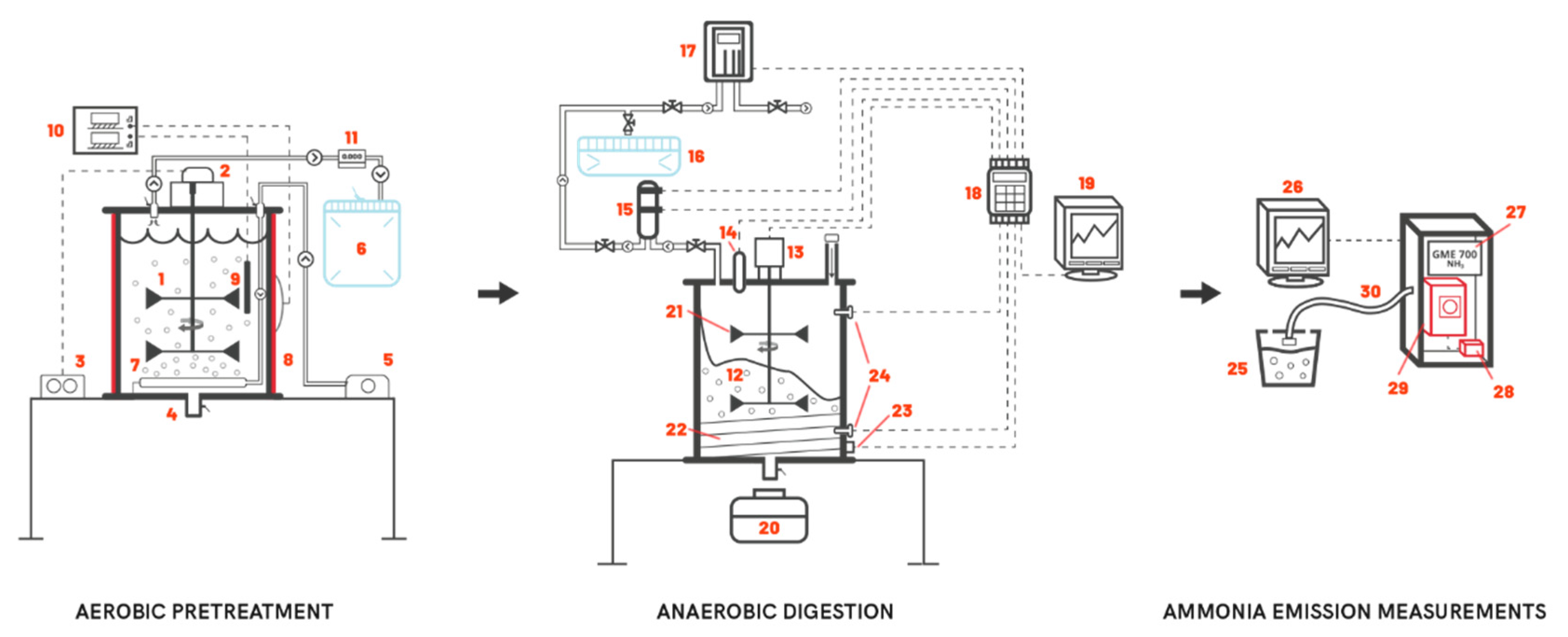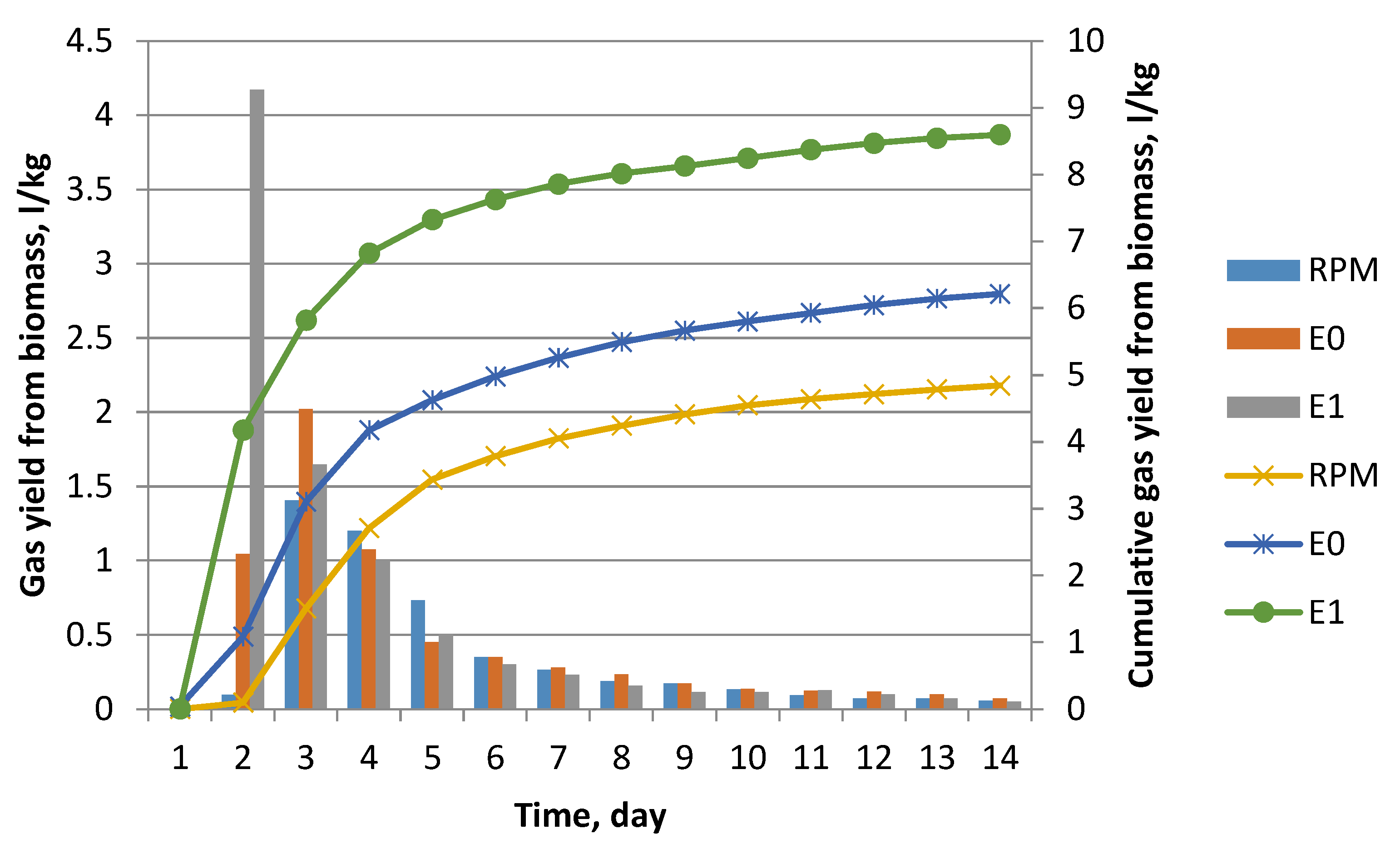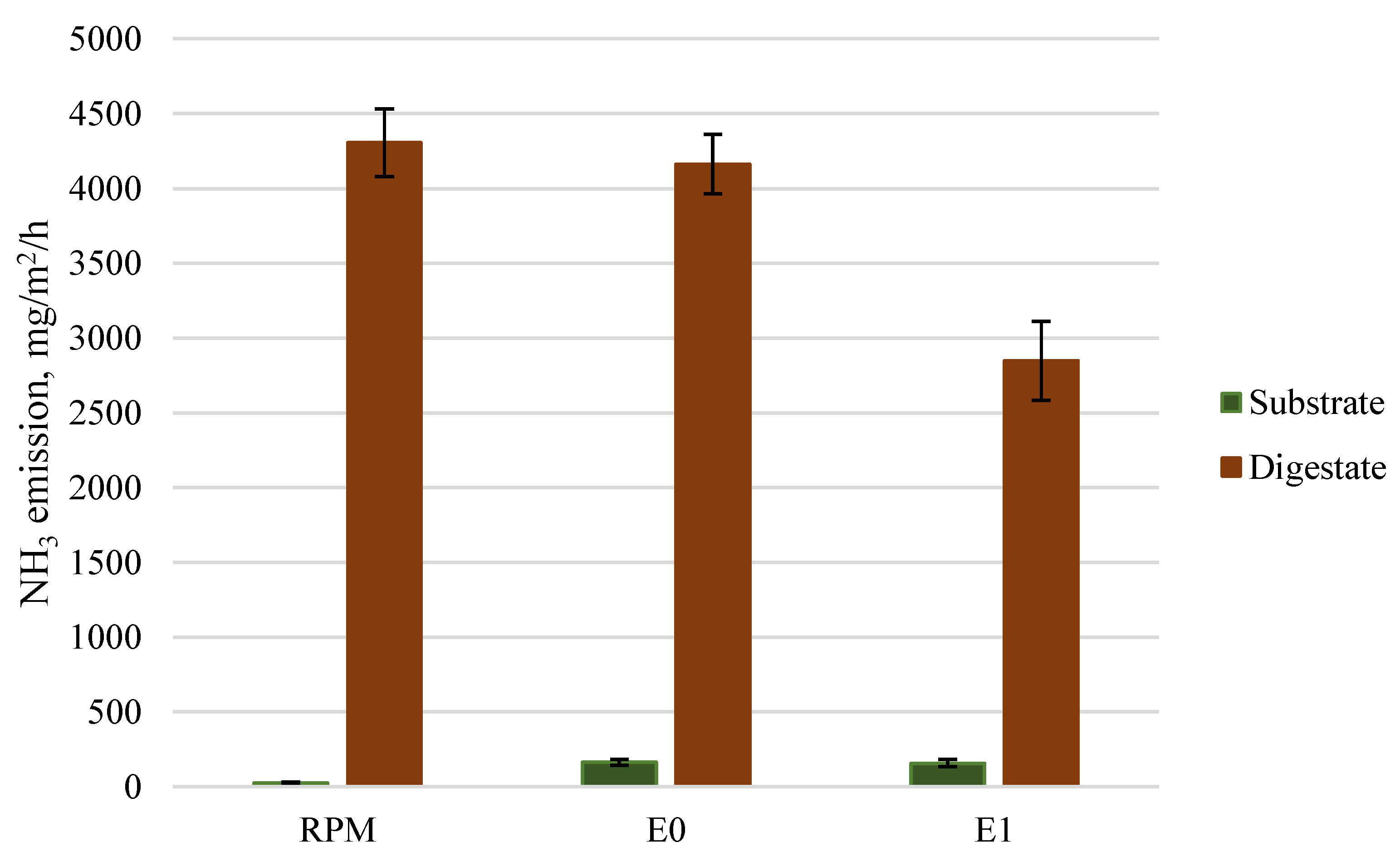Influence of Aerobic Pretreatment of Poultry Manure on the Biogas Production Process
Abstract
1. Introduction
2. Methodology
2.1. Raw Material Preparation
2.2. Pretreatment of Poultry Manure
2.3. Anaerobic Digestion Process
2.4. Ammonia Emission Measurements
2.5. Chemical Analysis
2.6. Data Processing
3. Results and Discussion
3.1. Aerobic Pretreatment
3.1.1. Chemical and Physical Properties
3.1.2. Gas Emission by Aerobic Pretreatment
3.2. Biogas, Methane Yields, and Energy Value
3.3. Ammonia Emission
4. Conclusions
Author Contributions
Funding
Conflicts of Interest
References
- Böjti, T.; Kovács, K.L.; Kakuk, B.; Wirth, R.; Rákhely, G.; Bagi, Z. Pretreatment of poultry manure for efficient biogas production as monosubstrate or co-fermentation with maize silage and corn stover. Anaerobe 2017, 46, 138–145. [Google Scholar] [CrossRef] [PubMed]
- Rodriguez-Verde, I.; Regueiro, L.; Lema, J.M.; Carballa, M. Blending based optimisation and pretreatment strategies to enhance anaerobic digestion of poultry manure. Waste Manag. 2018, 71, 521–531. [Google Scholar] [CrossRef] [PubMed]
- Scarlat, N.; Fahl, F.; Dallemand, J.-F.; Monforti, F.; Motola, V. A spatial analysis of biogas potential from manure in Europe. Renew. Sustain. Energy Rev. 2018, 94, 915–930. [Google Scholar] [CrossRef]
- Abouelenien, F.; Fujiwara, W.; Namba, Y.; Kosseva, M.; Nishio, N.; Nakashimada, Y. Improved methane fermentation of chicken manure via ammonia removal by biogas recycle. Bioresour. Technol. 2010, 101, 6368–6373. [Google Scholar] [CrossRef] [PubMed]
- Wang, Y.; Xue, W.; Zhu, Z.; Yang, J.; Li, X.; Tian, Z.; Dong, H.; Zou, G. Mitigating ammonia emissions from typical broiler and layer manure management—A system analysis. Waste Manag. 2019, 93, 23–33. [Google Scholar] [CrossRef] [PubMed]
- Andriamanohiarisoamanana, F.J.; Sakamoto, Y.; Yamashiro, T.; Yasui, S.; Iwasaki, M.; Ihara, I.; Tsuji, O.; Umetsu, K. Effects of handling parameters on hydrogen sulfide emission from stored dairy manure. J. Environ. Manag. 2015, 154, 110–116. [Google Scholar] [CrossRef]
- Zilio, M.; Orzi, V.; Chiodini, M.; Riva, C.; Acutis, M.; Boccasile, G.; Adani, F. Evaluation of ammonia and odour emissions from animal slurry and digestate storage in the Po Valley (Italy). Waste Manag. 2020, 103, 296–304. [Google Scholar] [CrossRef]
- Sürmeli, R.Ö.; Bayrakdar, A.; Molaey, R.; Çalli, B. Synergistic Effect of Sulfide and Ammonia on Anaerobic Digestion of Chicken Manure. Waste Biomass Valorization 2017, 10, 609–615. [Google Scholar] [CrossRef]
- Nie, H.; Jacobi, H.F.; Strach, K.; Xu, C.; Zhou, H.; Liebetrau, J. Mono-fermentation of chicken manure: Ammonia inhibition and recirculation of the digestate. Bioresour. Technol. 2015, 178, 238–246. [Google Scholar] [CrossRef]
- Chadwick, D.; Sommer, S.G.; Thorman, R.; Fangueiro, D.; Cardenas, L.; Amon, B.; Misselbrook, T.H. Manure management: Implications for greenhouse gas emissions. Anim. Feed. Sci. Technol. 2011, 514–531. [Google Scholar] [CrossRef]
- Chen, S.; He, J.; Wang, H.; Dong, B.; Li, N.; Dai, X. Microbial responses and metabolic pathways reveal the recovery mechanism of an anaerobic digestion system subjected to progressive inhibition by ammonia. Chem. Eng. J. 2018, 350, 312–323. [Google Scholar] [CrossRef]
- Gao, S.; Zhao, M.; Chen, Y.; Yu, M.; Ruan, W. Tolerance response to in situ ammonia stress in a pilot-scale anaerobic digestion reactor for alleviating ammonia inhibition. Bioresour. Technol. 2015, 198, 372–379. [Google Scholar] [CrossRef]
- Lin, L.; Xu, F.; Ge, X.; Li, Y. Improving the sustainability of organic waste management practices in the food-energy-water nexus: A comparative review of anaerobic digestion and composting. Renew. Sustain. Energy Rev. 2018, 89, 151–167. [Google Scholar] [CrossRef]
- Abraham, A.; Mathew, A.K.; Park, H.; Choi, O.; Sindhu, R.; Parameswaran, B.; Pandey, A.; Park, J.H.; Sang, B.-I. Pretreatment strategies for enhanced biogas production from lignocellulosic biomass. Bioresour. Technol. 2020, 301, 122725. [Google Scholar] [CrossRef]
- Bayrakdar, A.; Sürmeli, R.Ö.; Çalli, B. Dry anaerobic digestion of chicken manure coupled with membrane separation of ammonia. Bioresour. Technol. 2017, 244, 816–823. [Google Scholar] [CrossRef] [PubMed]
- Fuchs, W.; Wang, X.; Gabauer, W.; Ortner, M.; Li, Z. Tackling ammonia inhibition for efficient biogas production from chicken manure: Status and technical trends in Europe and China. Renew. Sustain. Energy Rev. 2018, 97, 186–199. [Google Scholar] [CrossRef]
- Zhang, Y.; Zhao, Y.; Chen, Y.; Lu, Q.; Li, M.; Wang, X.; Wei, Y.-Q.; Xie, X.; Wei, Z. A regulating method for reducing nitrogen loss based on enriched ammonia-oxidizing bacteria during composting. Bioresour. Technol. 2016, 221, 276–283. [Google Scholar] [CrossRef]
- Atelge, M.; Atabani, A.; Banu, J.R.; Krisa, D.; Kaya, M.; Eskicioglu, C.; Kumar, G.; Lee, C.; Yildiz, Y.; Unalan, S.; et al. A critical review of pretreatment technologies to enhance anaerobic digestion and energy recovery. Fuel 2020, 270, 117494. [Google Scholar] [CrossRef]
- Bayrakdar, A.; Sürmeli, R.Ö.; Çalli, B. Anaerobic digestion of chicken manure by a leach-bed process coupled with side-stream membrane ammonia separation. Bioresour. Technol. 2018, 258, 41–47. [Google Scholar] [CrossRef]
- Li, K.; Liu, R.; Yu, Q.; Ma, R. Removal of nitrogen from chicken manure anaerobic digestion for enhanced biomethanization. Fuel 2018, 232, 395–404. [Google Scholar] [CrossRef]
- Issah, A.-A.; Kabera, T.; Kemausuor, F. Biogas optimisation processes and effluent quality: A review. Biomass Bioenergy 2020, 133, 105449. [Google Scholar] [CrossRef]
- Shen, F.; Li, H.; Wu, X.; Wang, Y.; Zhang, Q. Effect of organic loading rate on anaerobic co-digestion of rice straw and pig manure with or without biological pretreatment. Bioresour. Technol. 2018, 250, 155–162. [Google Scholar] [CrossRef] [PubMed]
- Butkutė, B.; Lemežienė, N.; Kanapeckas, J.; Navickas, K.; Dabkevičius, Z.; Venslauskas, K. Cocksfoot, tall fescue and reed canary grass: Dry matter yield, chemical composition and biomass convertibility to methane. Biomass Bioenergy 2014, 66, 1–11. [Google Scholar] [CrossRef]
- Bleizgys, R.; Bagdonienė, I. Control of ammonia air pollution through the management of thermal processes in cowsheds. Sci. Total. Environ. 2016, 568, 990–997. [Google Scholar] [CrossRef] [PubMed]
- Li, Y.; Liu, Y.; Yong, X.; Wu, X.; Jia, H.; Wong, J.W.; Wu, H.; Zhou, J. Odor emission and microbial community succession during biogas residue composting covered with a molecular membrane. Bioresour. Technol. 2020, 297, 122518. [Google Scholar] [CrossRef] [PubMed]
- Cáceres, R.; Malińska, K.; Marfà, O. Nitrification within composting: A review. Waste Manag. 2018, 72, 119–137. [Google Scholar] [CrossRef] [PubMed]
- EPA. National Emission Inventory—Ammonia Emissions from Animal Husbandry Operations (Draft Report); United States Environ. Prot. Agency: Washington, DC, USA, 2004. [Google Scholar]
- Larsen, M.L.V.; Bertelsen, M.; Pedersen, L.J. Review: Factors affecting fouling in conventional pens for slaughter pigs. Animal 2017, 12, 322–328. [Google Scholar] [CrossRef]
- Ren, X.; Wang, Q.; Zhang, Y.; Awasthi, M.K.; He, Y.; Li, R.; Zhang, Z. Improvement of humification and mechanism of nitrogen transformation during pig manure composting with Black Tourmaline. Bioresour. Technol. 2020, 307, 123236. [Google Scholar] [CrossRef]
- Zhao, L.; Hadlocon, L.J.S.; Manuzon, R.B.; Darr, M.J.; Keener, H.M.; Heber, A.J.; Ni, J.-Q. Ammonia concentrations and emission rates at a commercial poultry manure composting facility. Biosyst. Eng. 2016, 150, 69–78. [Google Scholar] [CrossRef]
- Gao, M.; Liang, F.; Yu, A.; Li, B.; Yang, L. Evaluation of stability and maturity during forced-aeration composting of chicken manure and sawdust at different C/N ratios. Chemosphere 2010, 78, 614–619. [Google Scholar] [CrossRef]
- Chowdhury, A.; De Neergaard, A.; Jensen, L.S. Potential of aeration flow rate and bio-char addition to reduce greenhouse gas and ammonia emissions during manure composting. Chemosphere 2014, 97, 16–25. [Google Scholar] [CrossRef] [PubMed]
- Chaump, K.; Preisser, M.; Shanmugam, S.R.; Prasad, R.; Adhikari, S.; Higgins, B.T. Leaching and anaerobic digestion of poultry litter for biogas production and nutrient transformation. Waste Manag. 2019, 84, 413–422. [Google Scholar] [CrossRef] [PubMed]
- García-González, M.; Vanotti, M.; Szogi, A. Recovery of ammonia from swine manure using gas-permeable membranes: Effect of aeration. J. Environ. Manag. 2015, 152, 19–26. [Google Scholar] [CrossRef] [PubMed]
- Zhu, J.; Luo, A.; Ndegwa, P.M. The effect of limited aeration on swine manure phosphorus removal. J. Environ. Sci. Health Part B 2001, 36, 209–218. [Google Scholar] [CrossRef] [PubMed]
- Brémond, U.; De Buyer, R.; Steyer, J.-P.; Bernet, N.; Carrere, H. Biological pretreatments of biomass for improving biogas production: An overview from lab scale to full-scale. Renew. Sustain. Energy Rev. 2018, 90, 583–604. [Google Scholar] [CrossRef]
- Andriani, D.; Wresta, A.; Atmaja, T.; Saepudin, A. A Review on Optimization Production and Upgrading Biogas Through CO2 Removal Using Various Techniques. Appl. Biochem. Biotechnol. 2013, 172, 1909–1928. [Google Scholar] [CrossRef]
- Ács, N.; Bagi, Z.; Rákhely, G.; Kovàcs, E.; Wirth, R.; Kovács, K.L. Improvement of biogas production by biotechnological manipulation of the microbial population. In Proceedings of the 2011 IEEE 3rd International Symposium on Exploitation of Renewable Energy Sources, Subotica, Serbia, 11–12 March 2011. [Google Scholar] [CrossRef]
- Rodriguez, C.; Alaswad, A.; Benyounis, K.; Olabi, A.G. Pretreatment techniques used in biogas production from grass. Renew. Sustain. Energy Rev. 2017, 68, 1193–1204. [Google Scholar] [CrossRef]
- Wang, Q.; Peng, L.; Su, H. The effect of a buffer function on the semi-continuous anaerobic digestion. Bioresour. Technol. 2013, 139, 43–49. [Google Scholar] [CrossRef]
- Li, C.; Nges, I.A.; Lu, W.; Wang, H. Assessment of the degradation efficiency of full-scale biogas plants: A comparative study of degradation indicators. Bioresour. Technol. 2017, 244, 304–312. [Google Scholar] [CrossRef]
- Zou, S.; Kang, D. Relationship between anaerobic digestion characteristics and biogas production under composting pretreatment. Renew. Energy 2018, 125, 485–494. [Google Scholar] [CrossRef]
- Tabatabaei, M.; Aghbashlo, M.; Valijanian, E.; Panahi, H.K.S.; Nizami, A.-S.; Ghanavati, H.; Sulaiman, A.; Mirmohamadsadeghi, S.; Karimi, K. A comprehensive review on recent biological innovations to improve biogas production, Part 2: Mainstream and downstream strategies. Renew. Energy 2020, 146, 1392–1407. [Google Scholar] [CrossRef]
- Wang, H.; Zhu, X.; Yan, Q.; Zhang, Y.; Angelidaki, I. Microbial community response to ammonia levels in hydrogen assisted biogas production and upgrading process. Bioresour. Technol. 2019, 296, 122276. [Google Scholar] [CrossRef] [PubMed]
- Mao, C.; Feng, Y.; Wang, X.; Ren, G. Review on research achievements of biogas from anaerobic digestion. Renew. Sustain. Energy Rev. 2015, 45, 540–555. [Google Scholar] [CrossRef]
- Möller, K. Effects of anaerobic digestion on soil carbon and nitrogen turnover, N emissions, and soil biological activity. A review. Agron. Sustain. Dev. 2015, 35, 1021–1041. [Google Scholar] [CrossRef]
- Nkoa, R. Agricultural benefits and environmental risks of soil fertilization with anaerobic digestates: A review. Agron. Sustain. Dev. 2013, 34, 473–492. [Google Scholar] [CrossRef]
- Provolo, G.; Perazzolo, F.; Mattachini, G.; Finzi, A.; Naldi, E.; Riva, E. Nitrogen removal from digested slurries using a simplified ammonia stripping technique. Waste Manag. 2017, 69, 154–161. [Google Scholar] [CrossRef] [PubMed]
- Paranhos, A.G.D.O.; Adarme, O.F.H.; Barreto, G.F.; Silva, S.D.Q.; De Aquino, S.F. Methane production by co-digestion of poultry manure and lignocellulosic biomass: Kinetic and energy assessment. Bioresour. Technol. 2020, 300, 122588. [Google Scholar] [CrossRef]
- Cao, Y.; Wang, X.; Bai, Z.; Chadwick, D.; Misselbrook, T.; Sommer, S.G.; Qin, W.; Ma, L. Mitigation of ammonia, nitrous oxide and methane emissions during solid waste composting with different additives: A meta-analysis. J. Clean. Prod. 2019, 235, 626–635. [Google Scholar] [CrossRef]
- Ren, Y.; Ngo, H.H.; Guo, W.; Wang, D.; Peng, L.; Ni, B.-J.; Wei, W.; Liu, Y. New perspectives on microbial communities and biological nitrogen removal processes in wastewater treatment systems. Bioresour. Technol. 2020, 297, 122491. [Google Scholar] [CrossRef]



| Experiment Code | Method of Treatment | Duration of Processing, Days |
|---|---|---|
| RPM | Pretreatment was not applied | |
| E0 | Maintenance of aerobic conditions without inoculation of biological additives | 14 |
| E1 | Bacillus subtilis, Bacillus megaterium, Bacillus licheniformis, Bacillus amyloliquefaciens, Bacillus thuringiensis, cellulase, corn, wheat bran, and Yucca extract. | 14 |
| Research Parameter | Research Code | |||||
|---|---|---|---|---|---|---|
| Raw Material | Digestate | |||||
| RPM | E0 | E1 | RPM | E0 | E1 | |
| Dry matter (TS), % | 15.00 | 14.47 | 12.96 | 8.94 | 9.62 | 6.49 |
| Organic matter (VS), % | 12.83 | 10.49 | 11.18 | 5.51 | 6.94 | 4.58 |
| Total nitrogen (TN), % | 0.85 | 0.86 | 0.92 | 0.78 | 0.85 | 0.66 |
| Sulfur (S), mg/kg | 1246 | 1120 | 1059 | 387 | 557 | 373 |
| Ammoniacal nitrogen (TAN), g/L | 2.13 | 4.80 | 5.17 | 5.63 | 4.82 | 4.40 |
| Total carbon (TC), % | 7.33 | 6.75 | 5.32 | 4.06 | 4.46 | 3.07 |
| NO3−, mg/L | <2.00 | <2.00 | <2.00 | <2.00 | <2.00 | <2.00 |
| NO2−, mg/L | <0.05 | <0.05 | <0.05 | <0.05 | <0.05 | <0.05 |
| pH | 5.65 | 6.17 | 6.25 | 7.88 | 7.91 | 7.66 |
| C/N | 9/1 | 8/1 | 6/1 | 5/1 | 5/1 | 5/1 |
| CH4, % | CO2, % | CO, % | O2, % | H2S, ppm | H2, ppm | NH3, ppm | ||
|---|---|---|---|---|---|---|---|---|
| Days 1–7 | RPM | 1.53 | 52.06 | 0.62 | 4.27 | 510 | 21,530 | 3.27 |
| E0 | 0.00 | 49.13 | 0.02 | 1.50 | 5766 | 21,450 | 4.00 | |
| E1 | 0.12 | 48.90 | 0.00 | 5.72 | 2479 | 21,051 | 3.57 | |
| Days 7–14 | RPM | 0.40 | 39.20 | 0.01 | 13.34 | 0 | 399 | 2.24 |
| E0 | 0.27 | 45.35 | 0.00 | 5.83 | 114 | 2049 | 2.90 | |
| E1 | 0.11 | 27.53 | 0.00 | 1.94 | 17 | 0 | 3.57 |
| Indicator. | RPM | E0 | E1 |
|---|---|---|---|
| Biogas yield from biomass (BM), L/kg | 56.38 ± 3.19 | 53.44 ± 3.16 | 56.65 ± 2.20 |
| Biogas yield from dry matter (BTS), L/kg | 375.87 ± 21.30 | 403.95 ± 23.95 | 422.72 ± 16.51 |
| Biogas yield from organic matter (BVS), L/kg | 439.45 ± 24.90 | 510.78 ± 23.86 | 507.98 ± 19.65 |
| Methane concentration in biogas (CM), % | 54.92 ± 1.98 | 61.86 ± 1.39 | 62.89 ± 1.15 |
| Energetic value of biogas (eb), MJ/m3 | 19.39 ± 0.69 | 21.84 ± 0.49 | 22.20 ± 0.41 |
| Energy obtained from biomass (eM), MJ/kg | 1.09 ± 0.06 | 1.31 ± 0.08 | 1.26 ± 0.05 |
| Energy obtained from dry matter (eTS), MJ/kg | 7.28 ± 0.42 | 8.82 ± 0.54 | 9.37 ± 0.41 |
| Energy obtained from organic matter (eVS), MJ/kg | 8.52 ± 0.49 | 11.04 ± 0.10 | 11.27 ± 0.49 |
© 2020 by the authors. Licensee MDPI, Basel, Switzerland. This article is an open access article distributed under the terms and conditions of the Creative Commons Attribution (CC BY) license (http://creativecommons.org/licenses/by/4.0/).
Share and Cite
Rubežius, M.; Venslauskas, K.; Navickas, K.; Bleizgys, R. Influence of Aerobic Pretreatment of Poultry Manure on the Biogas Production Process. Processes 2020, 8, 1109. https://doi.org/10.3390/pr8091109
Rubežius M, Venslauskas K, Navickas K, Bleizgys R. Influence of Aerobic Pretreatment of Poultry Manure on the Biogas Production Process. Processes. 2020; 8(9):1109. https://doi.org/10.3390/pr8091109
Chicago/Turabian StyleRubežius, Mantas, Kęstutis Venslauskas, Kęstutis Navickas, and Rolandas Bleizgys. 2020. "Influence of Aerobic Pretreatment of Poultry Manure on the Biogas Production Process" Processes 8, no. 9: 1109. https://doi.org/10.3390/pr8091109
APA StyleRubežius, M., Venslauskas, K., Navickas, K., & Bleizgys, R. (2020). Influence of Aerobic Pretreatment of Poultry Manure on the Biogas Production Process. Processes, 8(9), 1109. https://doi.org/10.3390/pr8091109





